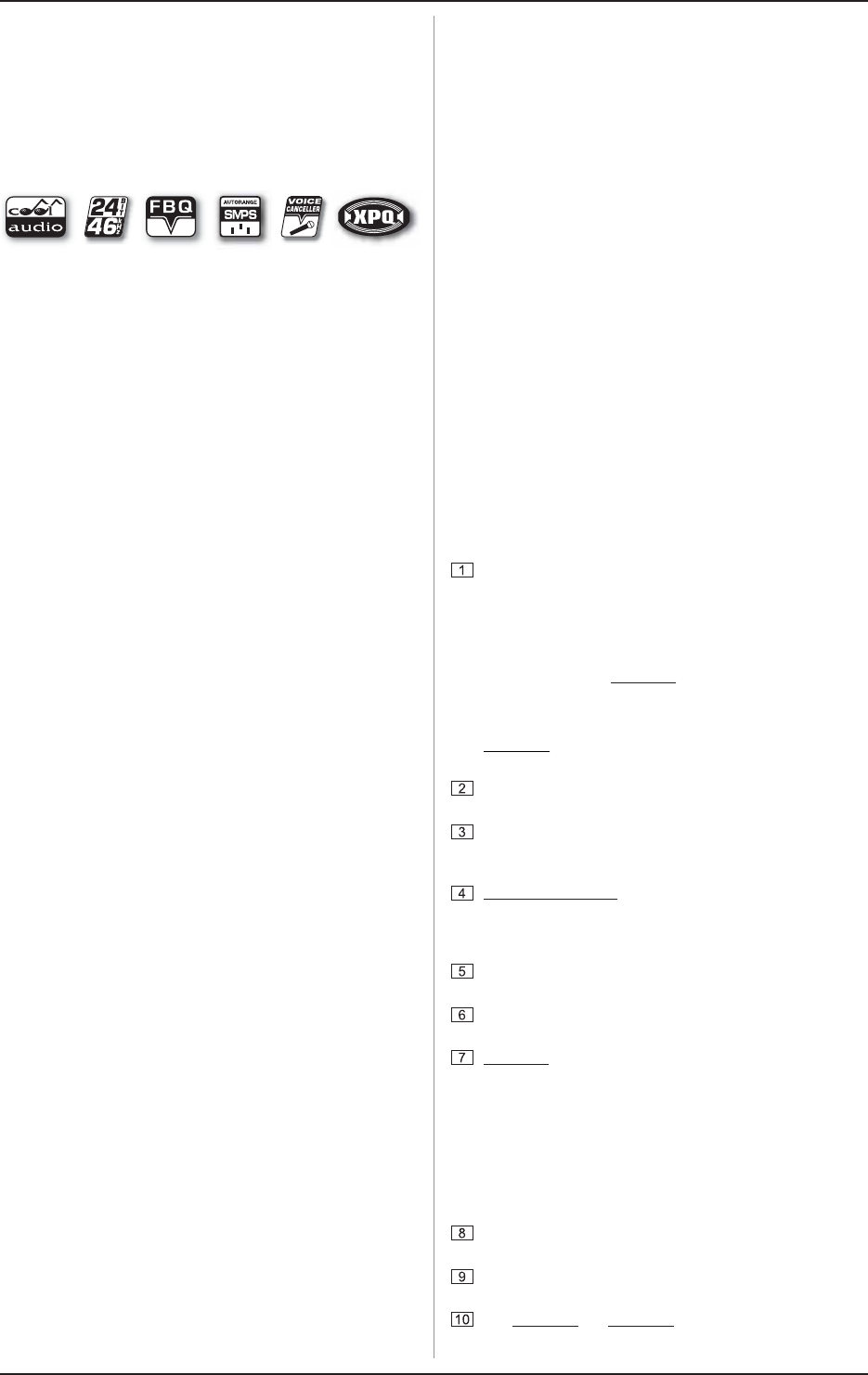
4
EUROPOWER PMH1000/PMH3000/PMH5000
1. INTRODUCTION
Congratulations! With the PMH1000/PMH3000/PMH5000 you
have acquired a state-of-the-art power mixer that sets new
standards. Right from the very start it has been our goal to
design a revolutionary unit that can be used for a wide variety of
applications. Indeed, this overwhelming power mixer gives you
plenty of functionality and a broad range of connection and
expansion options.
Your PMH features our revolutionary COOLAUDIO amplifier
technology, which reduces the weight and size of the unit
considerably and ensures extremely high output power.
Further advantages are the integrated Voice Canceller that
removes vocal passages from playbacks, the FBQ function,
which detects feedback frequencies, and the Speaker
Processing function for loudspeaker alignment—all with a
resolution of 24 bits and 46 kHz. Plus, our tried and tested
“Invisible” Mic Preamps give you crystal-clear audio free of noise
and distortion when using microphones.
The mixing consoles of the PMH series feature a state of the
art, integrated switch-mode power supply (SMPS). One of the
great advantages is that (compared to conventional circuits) a
switch-mode power supply adapts to mains voltages between
100 and 240 volts automatically. Furthermore, due to its much
greater efficiency, it consumes much less energy than a
conventional power supply unit.
BEHRINGER is a company with its roots in professional
recording studio technology. For many years we have been
successful in developing products for studio and live use. These
include microphones and 19" units of all types (compressors,
enhancers, noise gates, tube processors, headphone amplifiers,
digital effects, DI boxes, etc.), monitor and P.A. speakers and
professional live and recording mixers. Our entire technical know-
how has gone into your PMH power mixer.
1.1 Before you get started
1.1.1 Shipment
Your PMH was carefully packed at the factory and the
packaging is designed to protect the unit from rough handling.
Nevertheless, we recommend that you carefully examine the
packaging and its contents for any signs of physical damage
which may have occurred during transit.
If the unit is damaged, please do NOT return it to
BEHRINGER, but notify your dealer and the shipping
company immediately. Otherwise, claims for damage
or replacement may not be granted.
We recommend that you use a flight case, so as to give
your power mixer optimum protection during use or
transport.
Always use the original packing carton to prevent
damage during storage or transport.
Make sure that children cannot play unsupervised with
the device or its packaging.
Please ensure proper disposal of all packing materials.
1.1.2 Initial operation
Be sure that there is enough air space around the unit for cooling
and, to avoid overheating, please do not place the EUROPOWER
near radiators, etc.
Blown fuses must be replaced by fuses of the same type
and rating! Please refer to the “SPECIFICATIONS” for
details.
The mains connection is made using the enclosed power cord
and a standard IEC receptacle. It meets all of the international
safety certification requirements.
2. CONTROL ELEMENTS
Please make sure that all units have a proper
ground connection. For your own safety, never
remove or disable the ground conductor from the
unit or on the AC power cord.
1.1.3 Warranty
The EUROPOWER’s serial number is located on the rear of the
unit. Please take the time to fill in and return the warranty card
within 14 days after the date of purchase, so as to benefit from
our extended warranty. Or register online at
www.behringer.com.
1.2 The manual
This manual is designed to give you both an overview of all
control elements and to provide details about how to use them.
To provide you with a clear structure, we have grouped the control
elements according to their function. They can easily be found on
the enclosed numbered illustrations. If you need more detailed
information on specific topics, please visit our web site at
www.behringer.com.
2. CONTROL ELEMENTS
A detailed description of all functions of your power mixer can
be found in the following chapters. Please also refer to the
enclosed sheet with the numbered illustrations to get a good
overview of the control layout.
2.1 Mono and stereo channels
Use the TRIM control to adjust the input gain. Be sure to set
this control fully counter-clockwise before you connect or
disconnect a signal source to an input. TRIM controls both
the microphone and the LINE input. The black scale shows
the microphone gain (+10 to +60 dB on channels with
“INVISIBLE” MIC PREAMPS and 0 to +40 dB on conventional
microphone inputs; PMH1000 only, channels 5/6 and 7/8).
The “LINE” scale indicates the sensitivity of the LINE input,
ranging from +10 to -40 dBu.
PMH1000: The mono/stereo combination channels 5/6 and
7/8 have a sensitivity of +20 to -20 dBu.
The LEVEL SET LED illuminates when an optimum operating
level has been adjusted.
The mono channels are equipped with a high-slope LOW
CUT filter eliminating unwanted low-frequency signals like
rumble noise.
PMH3000/PMH5000 (stereo channels): Press the A/B button
to switch from 1/4" jacks to RCA connectors, and vice
versa. Position “A” = 1/4" jacks; position “B” = RCA
connectors.
The HIGH control in the EQ section governs the high
frequency range of the respective channel.
Use the MID control to boost or cut the midrange
frequencies.
PMH5000: The PMH5000 has an additional semi-parametric
filter for the midrange frequencies in the mono channels
(tunable from 100 Hz to 8 kHz). Adjust the boost/cut with
the MID control, and the frequency with the FREQ control.
The stereo channels contain a stereo EQ section. The cut-
off frequencies of the high and low bands are 12 kHz and
80 Hz respectively, while the center frequencies of the
high-mid and low-mid bands are 3 kHz and 400 Hz
respectively.
The LOW control allows you to boost/cut the low frequency
range.
With the MON(ITOR) control you can adjust the volume of
each channel in the monitor mix.
The PMH3000 and PMH5000 feature a second MON control
(MON 2) for the volume of the second monitor bus.
















